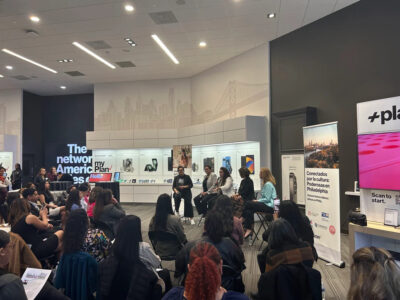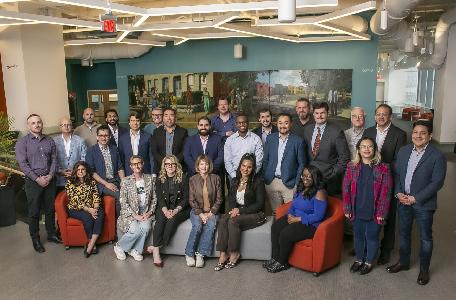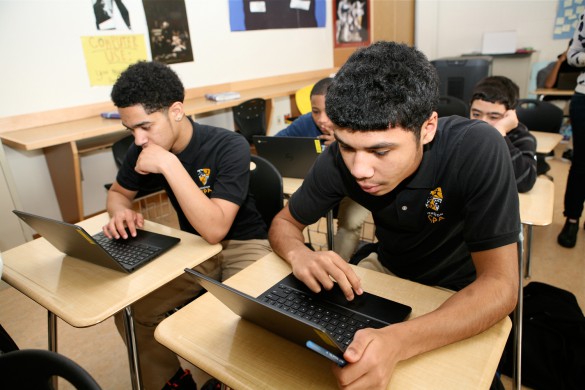Principals never have enough of anything. But the item at the top of Robert Caroselli’s technology wish list is telling.
“I’ll tell you what — they need servers,” he said. “Upgraded servers. Districtwide.”
As the leader of Fox Chase Elementary in Northeast Philadelphia, Caroselli finds himself on the front lines of the Philadelphia School District’s emerging tech culture. He knows what parents want. He knows what kids are doing. He knows how fast technology is evolving, and he knows that Fox Chase needs to keep up.
How? That is up to him.
We're trying to play catch-up with the rest of the community.
“I have kindergartners using Chromebooks,” he said. “They have Lexia, the intervention-based reading program. No one’s ever tried it with them, and we tried it this year, and our data is showing they’re moving their levels pretty quick. They’re really excited.
“I didn’t think we could do it at first. Then I said, wait a second — have high expectations! What the hell, try it!”
Like principals across the city, Caroselli finds himself in what could politely be called a challenging position.
“We’re trying to play catch-up with the rest of the community,” said the Northeast’s regional superintendent, Dion Betts. “They’re growing up in a technological environment, and we’re trying to create a technological environment in the schools.”
The Fox Chase tech arsenal is modest: a handful of laptops, an aging, crash-prone computer lab, a new suite of apps and a single elective computer skills class.
And the school’s progress will be hard to measure. District students take no mandatory tech-related tests. School performance measures don’t reflect the quality of the technical environment — except indirectly, if it affects test scores.
The District has a growing number of tools to help Caroselli — guidelines and strategies, connections to partners and quality content, suggested policies and options for students, and even the newly licensed app package he loves: “Google Docs, for me, has just turned things around.”
But just because officials see promise in technology doesn’t mean they’re making promises.
The District’s latest Action Plan deliberately avoids defining a baseline technical standard for all schools or calling for a districtwide boost in capacity. Technology can help schools “meet students where they are,” the plan says, but “not all schools will look the same.”
So in many respects, principals like Caroselli are on their own.
“What it comes down to is strong school leadership,” Betts said. “A principal who pushes the right things. Balancing the resources you have with the best practices you can implement.”
Spreadsheets for kindergartners?
Mary Beth Hertz is helping set the gold standard now, but that’s not where she began.
“Things have changed a lot in 10 years,” she said, recalling her first teaching position. “When I started, there was no computer lab. There was no library.”
Today, Hertz teaches at a new selective-admission high school, Science Leadership Academy @ Beeber, in Overbrook. Project-based and technology-infused, the school was recently honored by the White House as a national model.
But her first school, Bluford Elementary, was a different story. When it finally got a computer lab — “daisy chains of power strips” — Hertz was tapped as the technology teacher. The District’s curriculum offered only the most elemental guidance.
For many, many years, trying to transfer things to their homerooms was difficult.
“It was word processing, keyboarding, spreadsheets,” she recalled. “How do you teach spreadsheets to kindergartners? That’s where I had to start making up my own stuff.”
So Hertz took the online plunge, finding blogs and groups and discovering what was working for students. It soon became apparent that getting equipment into the building and teaching the basics was just the beginning.
“For many, many years, trying to transfer things to their homerooms was difficult,” she said.
Integrating computer skills with busy teachers’ lessons took planning and coordination. She rated it a big success when students used software to diagram the plants they were studying in science.
Today, at SLA @ Beeber, she finds herself at the other end of the scale.
On a recent afternoon, one group of students was designing a digital moisture-monitoring system for outdoor rain gardens. Another was refining a set of petal-shaped modular computer desks, designed to join together in rings for group work.
Every student has a Chromebook and a school email address. They work on a constant string of projects, alone and in teams, posting their work on the school blog. Technology is infused in everything they do.
But SLA remains the exception, not the rule. Brodie Bauman, a lanky SLA @ Beeber sophomore, smiled as he recalled his elementary school’s setup.
“We had a bunch of crappy Dells, and we just did typing classes all day,” Bauman said. “It was horrible. If I was working with somebody, it was the guy who happened to be next to me.”
Fortunately, his school, a charter, had solid academics; he earned a coveted SLA spot, and now he’s in his element.
He’s online when he wants to be. He’s got an internship with the Water Department, he likes geometry class and the bench he built, and he and his friends are teaching teachers to soup up their Chromebooks with Linux.
“We kind of figured it out on our own,” he said. “The teachers were like, ‘Oh, that’s cool!’”
Stories like that reflect the standard to which all schools should aspire, Hertz said.
“Once you start teaching with technology, you’re no longer the person in charge,” she said. “You don’t hold all the knowledge anymore. That’s a huge shift. You have to completely reimagine the way learning looks. Now kids can just Google it. You don’t have to stand up there and teach it.”
‘I learn from them’
If SLA is the gold standard, John B. Kelly is closer to bronze.
“We have a laptop cart, and it’s not always functional,” said Stephen Flemming, a 3rd-grade teacher in his eighth year at the Germantown elementary school. “There’s spaces for 24 computers, but now there’s only 10.”
Kelly’s ed-tech profile is typical of neighborhood schools. Hardware is limited: Jennings’ class has a single desktop for 26 students (“You have to schedule things”). Only some classrooms have smartboards. The Internet can be balky, the computers creaky.
At 3rd grade, they’re already on social media.
But the laptop cart stays busy and visits all the grades. Flemming’s 3rd graders squeeze in every minute of screen time they can, and like Bauman at SLA, they try to teach him a thing or two. When he suggests one batch of reading or math programs, they’ll go online and find more.
“They like looking and telling me what’s out there,” he said. “I learn from them as much as they learn from me.”
Flemming’s wish list for Kelly isn’t long: more tablets, more computers, more smartboards.
But he and his colleagues aren’t waiting on the District for everything. “A lot of us are going to social media to teach,” he said. “We’re using Instagram and Twitter to post pictures and homework.”
Parents and kids alike respond, he said. “They comment on pictures. They’ll use it. … At 3rd grade, they’re already on social media.”
District officials are leery of that kind of freelancing.
“I think teachers have to be very careful on social media with children,” said Fran Newberg, deputy chief of the District’s Office of Information Technology.
Principal Chris Lehmann at SLA’s main campus “is the beacon of how phenomenal it can be to use social media to engage kids. But I tend to be very cautious,” Newberg said.
Then she paused: “Maybe that’s a downside.”
Newberg knows educators have no choice but to feel their way through unfamiliar territory, not just with social media but with all forms of technology. The field is evolving fast, and the pressure is strong to step up.
The good news is that the next level isn’t necessarily a huge leap.
In Northeast Philadelphia, a financial gift is helping Ziegler Elementary go from the bronze standard — computer labs and occasional laptop time — to what could be called the silver: integrating technology into classroom lessons and projects.
The four-year grant of just under $1 million — about $250,000 a year — allows Zeigler to add a full-time technology specialist and outfit itself with plenty of high-quality technology, with an emphasis on the early grades.
Now some 1st graders are doing things that their parents can’t.
“Believe it or not, we’re coding,” said Kim Adair, the teacher whose job it is to bring tech into every classroom. “Kids are actually getting it. It’s amazing to watch.”
Ziegler is one of two schools to receive the grants, raised from two funders to replicate the literacy model of a private school, AIM Academy in Conshohocken. Kindergartners and 1st graders all have iPad carts. First graders code with a picture-based software program based on the Angry Birds video games. Older students do research and video projects.
In one, 8th graders filmed themselves doing mock high school interviews, and then watched and evaluated their performances.
“One girl finished [watching], and I said, ‘What did you see?’” Adair recalled.
“She said, ‘I had my hand on my hip the whole time.’ I said, ‘What does that signal to someone?’ And she said, ‘It’ll tell them that I have an attitude problem.’”
The student got it — and her next video was better, Adair said. It’s just one of many potentially life-changing lessons she sees constantly.
“I explain what they’re doing, and they help each other,” Adair said. “It’s not always about me. They’re building social skills.”
Still, with all the pressure on schools to meet test-score standards, she fears for creative programs like hers.
“They’ll hire more literacy teachers, and the tech teachers will get phased out,” Adair said. “[They’ll] say, ‘You must teach Lexia.’ They won’t get to see the spark in the kids’ eyes when they do the crazy projects I do.”
‘It’s bubbling up’
But Fran Newberg wants more programs like Ziegler’s, not fewer. She recalled with pleasure her recent visit to Kensington CAPA, where staff decided to invest some federal Title I dollars in a big batch of Chromebooks.
As Newberg watched students at digital workstations, engaged and excited, she remembered one student’s reaction in particular:
“This is how everyone else in the world works. Now we’re working with the rest of the world.”
It was thrilling, Newberg said. And her office has won praise for its efforts to support this learning, given the lack of funding for hardware and professional development.
“They deserve some kudos for staying on top of what’s new, encouraging teachers to try new things.” said Hertz.
But for now, such initiatives tend to be driven from the school level, not from the top down.
Superintendent William Hite’s latest Action Plan mentions countless goals that could be facilitated with technology — more personalized and blended learning, more collaboration and data-sharing, less “seat time” and more project-based learning. But it conspicuously avoids prescribing a tech vision for every school.
That’s no accident, Newberg said. Schools need to be able to develop at their own pace.
“We believe technology facilitates learning at multiple levels and didn’t need to be called out,” she said. “We didn’t want it to be a checklist. … We do believe in schools developing their own plans.”
And while Newberg has visions for what could be done with a larger and more stable funding stream, for now, the District’s baseline standards remain modest.
Every neighborhood school should have a learning lab and some laptops available for classroom use, Newberg said. A growing priority is to get computers into the classroom, at least a few in each (“It can be five. It doesn’t have to be 33.”). Internet connections should improve as the District moves to cloud-based computing. Her office offers a range of tools, options and suggested content and standards to help principals expand their tech offerings.
And although little is required of schools now, that could change. Newberg says there’s some discussion about requiring certain computer skills, and potentially even grading students on them.
But all that remains uncertain, as do future budgets. For now, to raise the standard districtwide, officials are sticking to what Dion Betts, the regional superintendent, called an “organic” strategy: Provide tools and guidance, and let school leaders drive change.
Principals are responding. More than 80 percent of schools now offer a basic computer skills elective. In the first year of the Google Apps for Education package, 182 schools have signed up so far. A handful are testing a new “bring your own device” policy, which allows students to bring their own phones and other devices into classrooms.
They just want their children to have what the other child has.
And what leaders can’t get from the District, some are managing to find elsewhere, through grants or partnerships. Fox Chase’s Caroselli did just that: He found an outside partner to donate his Chromebooks.
It was the only logical thing to do, he said.
“Parents just want their kids to compete. I talk to them on the baseball field, I talk to them in Target. They just want their children to have what the other child has.”
Newberg expects that kind of attitude will only grow. “It’s pressure,” she said. “It’s bubbling up from within.”
But if the overall trend is clear, each individual school remains a world of its own, and few tools are readily available to measure the depth and quality of their ed tech culture.
Sophisticated evaluation rubrics can assess innovation. But publicly available school evaluations like the School Progress Report don’t. A school can have lots of gear and use it poorly; it can run on a shoestring but still push the envelope.
It comes down to school culture, backed by District culture – leadership, support, resources, talent and, above all, the freedom to experiment and innovate.
Testing that culture may not be easy, but Mary Beth Hertz offered a simple standard of her own. “If you’re able to talk to a teacher, ask them, ‘What’s an example of a project the kids have done using technology?’ If they can’t answer that, you’ve got your answer.”
Join the conversation!
Find news, events, jobs and people who share your interests on Technical.ly's open community Slack

Philly daily roundup: A better coffee supply chain; Philly Tech Week returns; Apply to Pennovation Accelerator

Philly daily roundup: Startups want office culture; New Venture Lab cohort; Penn Med's new AI leader

Will the life sciences dethrone software as the king of technology?

